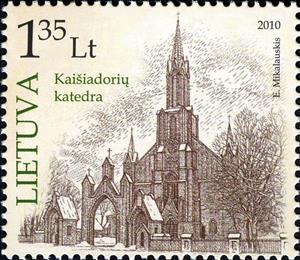Stamp: Kaisiadorys Transfiguration cathedral (Lithuania 2010)
Kaisiadorys Transfiguration cathedral (Lithuania 2010)
16 October (Lithuania ) within release The Churches of Lithuania goes into circulation Stamp Kaisiadorys Transfiguration cathedral face value 1.35 Lithuanian litas
| Stamp Kaisiadorys Transfiguration cathedral in catalogues | |
|---|---|
| Michel: | Mi:LT 1049 |
Stamp is horizontal format.
Artist E.MikalauskisAlso in the issue The Churches of Lithuania:
- Stamp - Kaisiadorys Transfiguration cathedral face value 1.35;
- Stamp - Telsiai Saint Anthony of Padua cathedral face value 1.35;
Stamp Kaisiadorys Transfiguration cathedral it reflects the thematic directions:
Religion is any cultural system of designated behaviors and practices, world views, texts, sanctified places, ethics, or organizations, that relate humanity to the supernatural or transcendental. Religions relate humanity to what anthropologist Clifford Geertz has referred to as a cosmic "order of existence". Different religions may or may not contain various elements ranging from the "divine", "sacred things", "faith", a "supernatural being or supernatural beings" or "some sort of ultimacy and transcendence that will provide norms and power for the rest of life". Religious practices may include rituals, sermons, commemoration or veneration (of deities), sacrifices, festivals, feasts, trances, initiations, funerary services, matrimonial services, meditation, prayer, music, art, dance, public service, or other aspects of human culture. Religions have sacred histories and narratives, which may be preserved in sacred scriptures, and symbols and holy places, that aim mostly to give a meaning to life. Religions may contain symbolic stories, which are sometimes said by followers to be true, that have the side purpose of explaining the origin of life, the Universe and other things. Traditionally, faith, in addition to reason, has been considered a source of religious beliefs. There are an estimated 10,000 distinct religions worldwide. About 84% of the world's population is affiliated with one of the five largest religions, namely Christianity, Islam, Hinduism, Buddhism or forms of folk religion.

